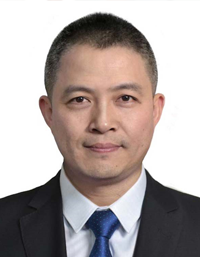Jinsong Li
Updated: 2021-09-06

Ph.D., Professor
Institute of Biochemistry and Cell Biology, Shanghai Institutes for Biological Sciences, CAS
Research Areas
Cellular reprogramming; Nuclear transfer; Haploid ESCs; Semi-cloned technology; Primordial germ cell development; Spermatogonial stem cells; Disease modeling
Research Interests
In 2012, we reported that the generation of androgenetic haploid embryonic stem cells (AG-haESCs) that can support full-term embryonic development upon injection into MII oocytes, leading to the generation of semi-cloned (SC) mice (Yang et al., Cell, 2012). However, one major drawback of this study is the frequently observed aberrant development of AG-haESC-derived embryos and the very low birth rate of healthy SC mice (around 2% of total SC embryos); this greatly restricts the applications of AG-haESCs. In 2015, we showed that AG-haESCs carrying deletions in the DMRs (differentially DNA methylated regions) controlling two paternally repressed imprinted genes, H19 and Gtl2, designated as DKO-AG-haESCs or ‘artificial spermatids’, can efficiently support the generation of SC pups at a rate of 20% (Zhong et al., Cell Stem Cell, 2015). Recently, through combining DKO-AG-haESCs and CRISPR-Cas9-mediated base editor system, we showed that mice with different base mutations can be generated in one step, enabling identification of critical amino acids of DND1 for primordial germ cell (PGC) development (Li et al., Nature Cell Biology, 2018).
Currently, we focus on the development of primordial germ cells, generation of disease models and large-scale tagging proteins in mice through ‘artificial spermatid’-mediated semi-cloned technology.
1. Identification of critical factors involved in PGC development and revealing underlying mechanisms.
2. Generation of disease models that mimic complex syndromes and understanding the pathological mechanisms.
3. Tagging every protein in mice (genome tagging project, GTP) and study of protein network during different germ cell development.
Study of underlying mechanisms of stemness and differentiation of spermatogonial stem cells.
Selected Publications
1、Li Y & Li J*. Technical advances contribute to the study of genome imprinting. PLOS Genet 2019. (Invited review)
2、Wang L & Li J*. ‘Artificial spermatid’-mediated genome editing. Biol Reprod 2019. (Invited review)
3、Wang J#, Chen J#, Wu G#, Zhang H#, Du X#, Chen S, Zhang L, Wang K, Fan J, Gao S, Wu X, Zhang S, Kuai B, Zhao P, Chi B, Wang L, Li G, Wong CCL, Zhou Y*, Li J*, Yun C* & Cheng H*. NRDE2 negatively regulates exosome functions by inhibiting MTR4 recruitment and exosome interaction. Genes & Dev 2019 Mar 10. DOI: 10.1101/gad.322602.118
4、Song W, Wang R, Jiang W, Yin Q, Peng G, Yang R, Yu QC, Chen J, Li J, Cheung TH, Jing N & Zeng Y. Hormones induce the formation of luminal-derived basal cells in the mammary gland. Cell Res 2019 Jan 10.
5、Li J* & Gao C*. Preface to the special topic on genome editing research in China. Nat Sci Rev 2019
6、Jiang Jing, Yan M, Li D & Li J*. Genome tagging project: tag every protein in mouse through “artificial spermatids”. Nat Sci Rev 2019
7、Lander E, Baylis F, Zhang F, Charpentier E, Berg P, Bourgain C, Friedrich B, Joung JK, Li J, Liu D, Naldini L, Nie JB, Qiu R, Schoene-Seifert B, Shao F, Terry S, Wei W & Winnacker EL. Adopt a moratorium on heritable genome editing. Nature 567(7747)(2019): 165-168.
8、Wang Haoyi, Li J, Li W, Gao C & Wei W. CRISPR twins: China Academy responds. Nature 564(7736)(2018): 345.
9、Li Qing, Li Y, Yang S, Huang S, Yan M, Ding Y, Tang W, Lou X, Yin Q, Sun Z, Lu L, Shi H, Wang H, Chen Y* & Li J*. CRISPR-Cas9-mediated base-editing screening in mice identifies DND1 amino acids that are critical for primordial germ cell development. Nat Cell Biol 20(11)(2018): 1315-1325. Epub 2018 Oct 01.
10、Chen Yao, Zheng Y, Gao Y, Lin Z, Yang S, Wang T, Wang Q, Xie N, Hua R, Liu M, Sha J, Griswold MD, Li J*, Tang F* & Tong M*. Single-cell RNA-seq uncovers dynamic processes and critical regulators in mouse spermatogenesis. Cell Res 28(9)(2018), 879-896. Epub 2018 Jul 30.
11、Qu Chao, Yan M, Yang S, Wang L, Yin Q, Liu Y, Chen Y & Li J*. Haploid embryonic stem cells can be enriched and maintained by simple filtration. J Biol Chem 293 (14) (2018): 5230-5235.
12、Li ZiYi, Huang M, Wang X, Zhu Y, Li J, Wong CCL & Fang Q. Nanoliter-scale oil-air-droplet chip-based single cell proteomic analysis. Anal Chem 90(8)(2018), 5430-5438. Epub 2018 Mar 27.
13、Liu Wuqing, Li S, Zhang Y, Li J & Li Y. Efficient CRISPR-based genome editing using tandem guide RNAs and editable surrogate reporters. FEBS Open Bio 8(7)(2018), 1167-1175.
14、Wang Xiukun & Li J*. An intermediate cell state allows rerouting of cell fate. J Biol Chem 292(46)(2017), 19133-19134. (Highlight).
15、Wei Leixin, Wang X, Yang S, Yuan W* & Li J*. Efficient generation of the mouse model with a defined point mutation through haploid cell-mediated gene-editing. J Genet Genomics 44(9)(2017), 461-463. Aug 12.
